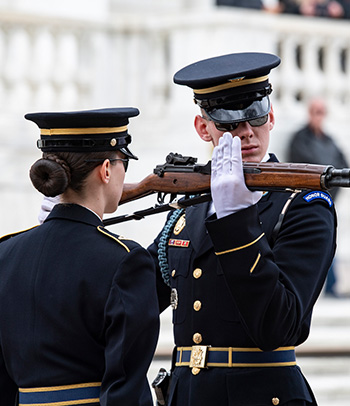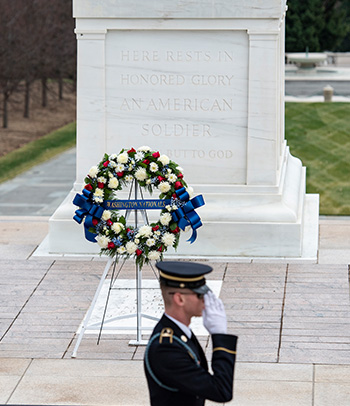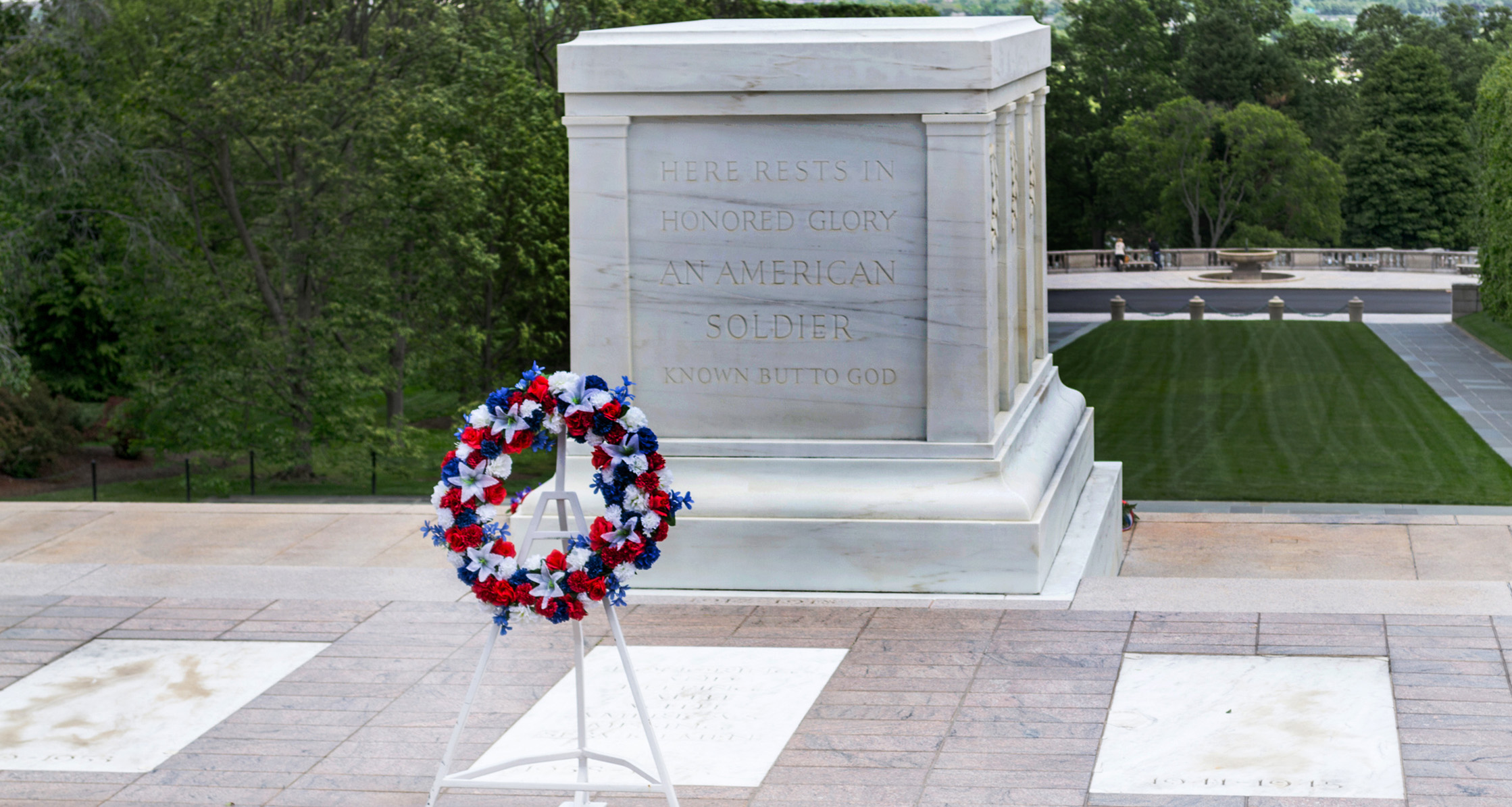Here rests in honored glory an American soldier known but to God.” – the inscription on the back of the Tomb of the Unknown Soldier
On Memorial Day each year, we honor the men and women who sacrificed their lives for our country and the freedoms we all enjoy. Many Americans spend the day visiting cemeteries, attending parades, holding family gatherings and finding special ways to remember our fallen heroes.
One way we can all pay tribute to the men and women who gave their lives in service to our country is to learn more about one of our country’s most iconic memorials – The Tomb of the Unknown Soldier located at Arlington National Cemetery, in Arlington, Va.
Each year, on Memorial Day, the President of the United States (or the President’s designee), lays a wreath on the Tomb of the Unknown Soldier during a remembrance ceremony in front of thousands of people. Learn more about this special memorial, its history and significance, and how it serves as a powerful tribute to all of our country’s fallen heroes.
The History of the Tomb of the Unknown Soldier
Throughout history, one of the heartbreaking consequences of war has been the large number of unidentified remains of Service members who lost their lives. In the past, whether due to poor record keeping, the damage inflicted on the body or the necessity to bury the dead in a quick manner, unidentified remains were common. For example, during the Civil War, the combination of high casualty rates and a lack of personal identification led to large numbers of soldiers being buried along marching routes or in battlefields.
During World War I, Service members carried identification discs that would help in the process of identifying remains, and a new unit called the Graves Registration Service began to oversee burials. But with more than 100,000 U.S. casualties, it was hard to fathom how the country could repatriate so many remains from overseas. If requested, remains could be transported from Europe to anywhere in the U.S. or be buried at permanent U.S. military cemeteries established overseas.
According to information from Arlington National Cemetery’s educational materials, soon after the end of the war, in 1920, a New York Congressman and WWI Veteran named Hamilton Fish Jr. proposed legislation that provided for the interment of one unknown American soldier at a special tomb to be built in Arlington National Cemetery. This proposed tomb would become the Tomb of the Unknown Soldier, whose purpose was “to bring home the body of an unknown American warrior who in himself represents no section, creed or race in the late war and who typifies, moreover, the soul of America and the supreme sacrifice of her heroic dead.”
An extensive process unfolded in order to select the body of a soldier for the Tomb. According to Arlington National Cemetery, four bodies of unidentified U.S. military personnel were exhumed from different cemeteries throughout France. Out of the four caskets, the Unknown Soldier was selected and journeyed all the way from France to Washington, D.C. A funeral ceremony was held at Arlington National Cemetery where President William G. Harding placed the Medal of Honor, the nation’s highest military decoration, on the casket. The Unknown was then interred in the Tomb of the Unknown Soldier.
The tomb itself is made of white marble and is decorated with three wreaths on each side panel. On the front, three figures represent Peace, Victory and Valor. The back features the inscription: “Here rests in honored glory an American soldier known but to God.” During its early years, thousands of people came to Arlington National Cemetery, to this tomb, to mourn and pay their respects to both the Unknown Soldier and all of the military members he represented.
In 1956, after both World War II and the Korean War, President Dwight D. Eisenhower approved the selection and interment of Unknowns from both wars to be placed in the Tomb alongside the original Unknown Soldier. In 1958, a similar process was used to choose the remains. Thirteen bodies were exhumed from military cemeteries across North Africa and Europe, as well as five more from an American cemetery in the Philippines to represent WWII. An additional four bodies were exhumed from a cemetery in the Philippines to represent those killed in the Korean War. Of these remains, one casket representing WWII and one casket from the Korean War were selected and transported to Washington, D.C. to be interred into crypts to the west of the original WWI Unknown Soldier.
Several years later, another set of remains was added to the Tomb of the Unknown Soldier. In 1984, only one set of recovered American remains from the Vietnam War had not been fully identified. In a ceremony at Pearl Harbor, those remains were designated as the Vietnam War Unknown, and on Memorial Day of that year, President Ronald Reagan presided over the interment ceremony, placing the remains in an added third crypt to the Tomb.
The Vietnam War Unknown would lay at rest at the Tomb of the Unknown Soldier for almost 14 years, but his remains were eventually identified and later returned to the family for burial. Now the third crypt remains empty, representing each of the missing Service members from Vietnam.
The Tomb’s Significance
The Tomb of the Unknown Soldier has become a powerful symbol of service and sacrifice. It not only serves as a symbolic grave for our fallen heroes whose remains have not been found or identified, but it has evolved to represent the memory of all of our Service members who made the ultimate sacrifice.
Arlington National Cemetery’s website contain a quote from a New York Tribune article from the time of the Tomb’s creation which calls the Unknown Soldier “a silent comforter of thousands of mothers whose sons are in unnamed graves in France.” The Tribune article also shares that the Tomb serves as a reminder that the nation hasn’t forgotten the millions “who were led by the drums of liberty to graves that may be unnamed, but which are not unhonored.”
The Guarding of the Tomb
When the Tomb of the Unknown Soldier was created, soldiers from nearby Fort Myer in Virginia were assigned to guard it in an attempt to discourage visitors from climbing or stepping on the Tomb.
Starting in 1948, soldiers from the 3rd U.S. Infantry Regiment, known as “The Old Guard,” have stood watch over the Tomb, guarding it 24 hours a day, 365 days a year in all but the most extreme weather conditions.
The guards or “Sentinels” are considered the elite of the 3rd U.S. Infantry Regiment and must be in superb physical condition, possess an unblemished military record and meet specific height requirements. They are chosen only after rigorous training and examinations, which include learning the history of Arlington National Cemetery, the grave locations of nearly 300 Veterans, the procedures for the guard-change ceremony and much more.
Every hour from October to March and every 30 minutes from April through September, a choreographed changing of the guard occurs at Arlington National Cemetery. A relief commander appears on the plaza to announce the changing of the guard. The commander walks out to the Tomb, salutes, then faces the spectators and asks them to stand and remain silent during the ceremony. The ceremony includes an inspection of the rifle held by the Guard, a salute to the Unknown Soldiers and the passing of orders to the new Tomb Guard.
The Tomb Guard marches exactly 21 steps down the black mat behind the Tomb, turns, faces east for 21 seconds, turns, faces north for 21 seconds, then takes 21 steps back down the mat and repeats the process. Next, the Tomb Guard places the rifle on the shoulder closest to the visitors, signifying that he or she stands between the Tomb and any possible threat. The number 21 symbolizes the 21-gun salute – the highest military honor that can be bestowed.
Visitors to Arlington National Cemetery can watch the Changing of the Guard, visit the Tomb and complete a tour of the cemetery.
Additional Resources
Learn more about the Tomb of the Unknown Soldier, the changing of the Guard and much more by visiting the Arlington National Cemetery website.
No matter how you choose to celebrate Memorial Day this year, consider taking a moment to reflect upon the history and significance of the Tomb of the Unknown Soldier. Learning about the memorial is another way you can honor the service and sacrifice of our country’s brave and selfless heroes.







